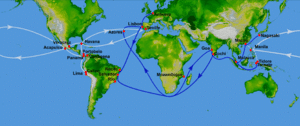Where are Chili Peppers From?
When I first learned that Chili Peppers are not indigenous to Asia, I was shocked. How could this spice, so essential to the Indian cuisine that I grew up enjoying, not be from India? It is possible that there was once…Indian cuisine without chilies? Where are chili peppers from?

Map showing main Portuguese (blue) and Spanish (white) oceanic trade routes in the 16th century,(credit: Wikipedia)
Chilies, along with potatoes, squash, tomatoes, chocolate, peanuts, all come from the new world, the Americas. They were one of many new world food stuffs to be readily incorporated into old world cuisine. But the chili pepper…there was something special about it.
The 1500’s, the so-called Age of Discovery, when ships set sail from Europe around the world in frenzied rush for gold, converts, leading to the destructions of vast civilizations in the America’s. It was this world that the chili pepper entered.
In fact, the spice trade, led by the champion spice, black pepper, had existed for hundreds of years before the ships connected the new world with the old. Chilies, thus, entered this existing trade superhighway, spreading with rapid speed through its many ports and cultures, around Africa and into the spice heartlands of Asia.
Evidence shows chilies first arrived in Indonesia in 1540, and India in 1542, and China shortly thereafter. They were quickly adopted and integrated into the local cusines with a speed and furvor as unique and fascinating as the chili is spicy.
Chili peppers certainly had advantages over other spices. It is a flowering fruit that produces ample spice, its seeds are durable and easy to transport over long distances, and when dried, they are lightweight but maintain their fiery punch. They also can adapt to grow in a wide variety of climates. These factors definitely played a role in why the chili was so integrated into Asian cuisines and culture, so much so that, we (spice-loving peoples) soon forgot where they came from. Or that they were even foreign. And really, were they foreign anymore? As they transformed us, we transformed them too.
I was not the only one who was shocked to learn the truth about chilies. Europeans, the same people who traveled the world in search of spices, who were responsible for introducing the chili pepper to the old world, forgot about its origins too. One of the original species of chilies is called Frutuscens Chinense, was named so because early botanists thought the chili pepper came from, well, China. Other Europeans thought that its origin was India, because the cuisine was too spicy for their palates.
It is no surprise, really. The use of chili peppers in Indian, Thai, or Szechuan cuisines is far more liberal than that of Bolivian or Brazilian cuisines (nearby Mexico is a notable exception). The spiciest chili in the world isn’t in South America, but in the hills of Nagaland, India, the Bhut Jolokia.
But the science and history is clear. Chili peppers came from South America and spread around the world rapidly, being adopted and integreted into diverse cultures and, in essence, changing them.
The question is, how? This project aims to discover the secret of the chili pepper, how it spread to fast, and how its unique uses define culture globally. Join me in this quest.
